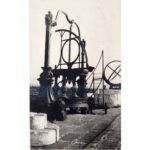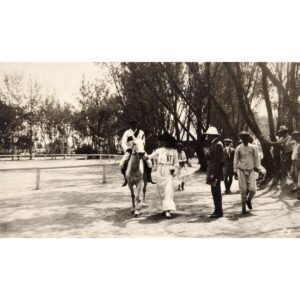Photography Emperor’s Tent Next to Qinian Hall at the Temple of Heaven
A black-and-white photograph showing the emperor’s yurt tent on the platform next to the Qinian Hall (Qiniandian 祈年殿), which was used for changing clothes and was erected only during ceremonies. A group of men, including a Westerner wearing a tall top hat, stands in front of the entrance to the tent. Five ceremonial pillars stand in front of the tabernacle. The tent is part of a several-hectare fenced compound in the north of the Temple of Heaven complex (Tiantan 天壇) in Beijing, which was built in 1420 by the Yongle emperor (reigned 1402–1424). Here the emperors of the Ming and Qing dynasties performed the rites of heavenly worship twice a year. In the Qinian Hall, on the day of the summer solstice, the emperor made offerings to the heavens and the ancestors, asking them for favours for the coming half year. In the tent, the emperor changed from his usual yellow robes to the ceremonial blue. Today a wooden pavilion stands here with the same purpose.
The Qinian ... more
A black-and-white photograph showing the emperor’s yurt tent on the platform next to the Qinian Hall (Qiniandian 祈年殿), which was used for changing clothes and was erected only during ceremonies. A group of men, including a Westerner wearing a tall top hat, stands in front of the entrance to the tent. Five ceremonial pillars stand in front of the tabernacle. The tent is part of a several-hectare fenced compound in the north of the Temple of Heaven complex (Tiantan 天壇) in Beijing, which was built in 1420 by the Yongle emperor (reigned 1402–1424). Here the emperors of the Ming and Qing dynasties performed the rites of heavenly worship twice a year. In the Qinian Hall, on the day of the summer solstice, the emperor made offerings to the heavens and the ancestors, asking them for favours for the coming half year. In the tent, the emperor changed from his usual yellow robes to the ceremonial blue. Today a wooden pavilion stands here with the same purpose.
The Qinian Hall was the central venue for summer ceremonies, which were quite different from the winter ceremonies. The emperor and officials spent two days in the temple. The first day was devoted to preparations and the emperor’s private homage to the ancestral plates. The second day was devoted to the official ceremony. The last emperor to bow to heaven in the Temple of Heaven was Yuan Shikai 袁世凱 (reigned 1915–1916), who for several months tried in vain to revive the monarchy. This marked the end of a centuries-old tradition. Today, the Temple of Heaven is on the UNESCO World Cultural Heritage List, as it is the largest religious complex in the world.
The photograph is the 178th of 449 photographs of Beijing and its surroundings in the album of Ivan Skušek Jr., purchased during his stay in Beijing (1914–1920). In the handwritten inventory of the album, the photograph is referred to as Himmels-Tempel: Hauptaltar mit Kaiserzelt (nur an Opfertagen). (DZ, MV)





































Do you have a comment or additional information about the subject?